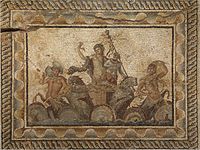
Photo from wikipedia
The 3D reconstruction of the Great Pitiunt Fortress has been our long-term goal. The results of archaeological excavations have revealed traces of a mosaic floor in one of the temples.… Click to show full abstract
The 3D reconstruction of the Great Pitiunt Fortress has been our long-term goal. The results of archaeological excavations have revealed traces of a mosaic floor in one of the temples. It was impossible to carry out a full reconstruction of the temple without first restoring the mosaic floor. The area of the preserved mosaic found during the excavations was only 33 square meters. This is 10.5% of the total interior area of the temple of 317 square meters. However, based on a number of reasons, i.e., the direction of the dividing borders between the elements of the mosaic, the requirement of symmetry of individual sections, the adjustment of motifs and the analysis of similar contemporaneous sites, it was possible to make a version of the general view of the reconstructed mosaic floor for further processing in the 3D reconstruction of the temples of the complex. This article provides the methods described, an analysis and justification of the reconstructed design of the mosaic in fragments and a holistic final model. The stylistic features of the mosaic have been identified, and the reasons for the dating of the mosaic have been given.
Journal Title: Applied Sciences
Year Published: 2023
Link to full text (if available)
Share on Social Media: Sign Up to like & get
recommendations!